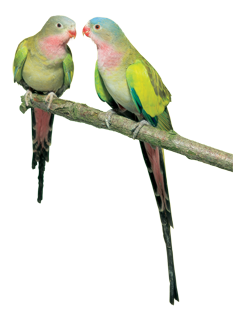Profiles
Princess Parrot
This sensational bird is 42cm to 45cm in length and has a pale blue-grey forehead and upper head, olive-coloured neck, back and upper-tail coverts with a brownish tint, pale pink throat, cheeks and chin, a grey-green breast and abdomen, pink tibia, red beak and an olive-green upper tail.
The males slight elongation of the third primary flight feathers, the so-called spatula tip, bend in an upward curl; have a purple-blue rump, deeper red beak, longer tail, and deeper blue colour on head.
The females have shorter tails than the male, and they have grey-blue rumps; their beaks are less red in colour than the male, in fact in all colours are paler, coverts narrower and more olive-green; slate-blue lower back. The offspring resemble the adult female until they reach 18 months of age.
Maintenance:
The Princess Parrot is now rarely seen in the wild. However, their natural habitat is Western Central Australia, where they roam around nomadically in small flocks of 10 to 15 birds. There they live as colonial breeders (sometimes 10 or more birds may nest in a single tree on a water-fed creek). They were first bred for captivity in Australia in 1899.
The Princess Parrot is not suited to cage habitation; it must have the use of an indoor or outdoor aviary measuring at least 2m x 2m x 4m (with a heated shelter). As with all parrots, it should not be kept on its own, but in pairs or small colonies (in this case, the individual pairs - no more than two - must be housed in the aviary at the same time in order to avoid any aggressive behaviour). This method of co-habitation will bring about the best breeding results. For breeding purposes, a nesting box measuring 25cm x 25cm x 60cm should be made available.
Princess Parrots like to eat a mix of TRILL™ budgie food and TRILL™ parrot food. They should always be fed green food such as chickweed, dandelion, parsley, and seeds bearing wild herbs. It is also beneficial for them to eat fruit, vegetables and twigs for playing and pecking.
Characteristics:
Name: Princess Parrott, Princess of Wales Parrot
Family: Parrot
Genus: Polytelis
Origin: Central Australia
Size: Large
Care: Not difficult, need large aviary
Temperament: Friendly, self-confident, not timid, quiet
Call: Loud call
Features: Best suited to aviary living.
